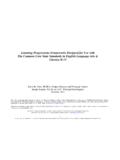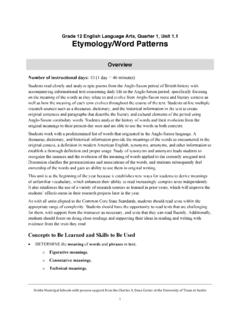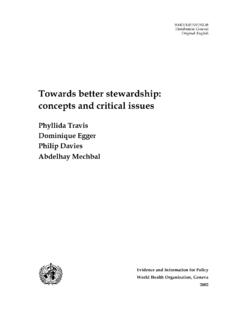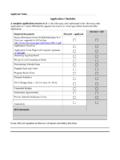Transcription of Core Standards for Intensive Care Units
1 BCore Standards forIntensive care UnitsEdition 12013 British Association ofCritical care NursesCritical care NetworkNurse LeadsCritical care Group of the UKCPAB ritish DieteticAssociationRoyal College of NursingUnited Kingdom Clinical Pharmacy AssociationRoyal College of Speech& Language TherapistsChartered Society ofPhysiotherapyCore Standards for Intensive care Units Edition 1 / 2013 CONTENTS CONTENTS DEFINITION .. 3 1. STAFFING .. 4 Medical Staff .. 4 Nursing Staff .. 7 Therapy Team .. 11 Pharmacy .. 13 Dietitians .. 15 2. OPERATIONAL .. 16 3. EQUIPMENT .. 20 4. DATA COLLECTION .. 21 BIBLIOGRAPHY.
2 22 DEVELOPMENT GROUP .. 26 2 core Standards for Intensive care Units Edition 1 / 2013 DEFINITION DEFINITION An Intensive care unit (ICU) is a specially staffed and equipped, separate and self-contained area of a hospital dedicated to the management and monitoring of patients with life-threatening conditions. It provides special expertise and the facilities for the support of vital functions and uses the skills of medical, nursing and other personnel experienced in the management of these problems. It encompasses all areas that provide Level 2 (high dependency) and/or Level 3 ( Intensive care ) care as defined by the Intensive care Society document Levels of Critical care for Adult Patients (2009).
3 ICU staff also provide services outside of the ICU such as emergency response ( rapid response teams) and critical care outreach services. Where applicable the hospital must provide adequate resources for these activities. Depending upon the designated level, function, size and case mix of the hospital and/or region that it serves, an ICU may range from four to over 50 beds. Large ICUs should be divided into pods of 8-15 patients. These Standards apply to all Units capable of looking after Level 2 or Level 3 critically ill patients, whether they are called Intensive care , Critical care or High Dependency Units and no distinction is made between them.
4 3 core Standards for Intensive care Units Edition 1 / 2013 STAFFING / Medical Staff 1. STAFFING Medical Staff Standard Additional rationale/consideration References care must be led by a Consultant in Intensive care Medicine The Closed unit model of Intensive care has been shown to improve mortality and morbidity. A Consultant in Intensive care Medicine is a Consultant who is a Fellow/Associate Fellow or eligible to become a Fellow/Associate Fellow of the Faculty of Intensive care Medicine. A Consultant in Intensive care Medicine will have Daytime Direct Clinical care Programmed Activities in Intensive care Medicine written into their job plan. These Programmed Activities will be exclusively in Intensive care Medicine and the Consultant may not cover a second specialty at the same time.
5 Wilcox ME, Chong CKAY, Niven DJ et al. Crit care Med. 2013, Baldock G, Foley P, Brett care Med. 2001 May;27(5):865-72 Pronovost PJ, Angus DC, Dorman T, et al. JAMA. 2002;288(17):2151 2162. Consultant work patterns should deliver continuity of care Analysis of UK Intensive care Medicine Consultants, demonstrate that the majority work blocks of days at a time. This is to be commended for maintaining continuity of care . 5 day blocks of day shifts on ICU have been shown to reduce burn-out in intensivists and maintain the same patient outcomes as 7 day blocks. A minority of Units still have different Consultants covering for 24-hour blocks throughout the week. Ali NA, Hammersley J, Hoffman SP, et al.
6 Am J Respir Crit care Med. 2011 Oct 1;184(7):803-8 FICM Workforce Advisory Group In general, the Consultant/ Patient ratio should not exceed a range between 1:8 1:15 and the ICU resident/Patient ratio should not exceed 1:8 The best current evidence is a Consultant/ patient ratio in excess of 1:14 is deleterious to patient care and Consultant well being. However the actual ratio needs to be determined by the following factors: Case Mix Patient Turnover Ratios of Trainees Experience of Trainees Telemedicine Surge Capacity Valentin A, Ferdinande P. Int care Med. 2011; 37(10) Volume 37: 1575-1587 Ward NS,Afessa B, Kleinpell R. CCM. 2013; 41(2): 638 645 CICM. IC-01 (2011) Landrigan CP, Rothschild JM, Cronin JW, et al.
7 N Engl J Med (2004) 351:1838 1848 4 core Standards for Intensive care Units Edition 1 / 2013 STAFFING / Medical Staff Standard Additional rationale/consideration References An ICU resident may be a medical trainee, SAS doctor or Advanced Critical care Practitioner. It is not appropriate for a Foundation Year doctor to be left as the sole resident doctor on an ICU. There must be immediate access to a practitioner who is skilled with advanced airway techniques. There must be a designated Clinical Director and/or Lead Consultant for Intensive care Intensive care is recognised as essential to acute and elective care provision in the modern hospital. If there is only a Lead Consultant, there must be a clear line of managerial accountability.
8 In larger hospitals, the Clinical Director should only have managerial responsibility for Intensive care , although this may comprise more than 1 unit . For example, the Clinical Director may be managerially re sponsible for a General ICU, Neuro ICU, Paed ICU and Cardiac ICU. Each separate unit would be expected to have a lead Consultant. Valentin A, Ferdinande P. Int care Med. 2011; 37(10) Volume 37: 1575-1587 CICM. IC-01 (2011) DH. Comprehensive Critical care . (2000) A Consultant in Intensive care Medicine must be immediately available 24/7, be able to attend within 30 minutes and must undertake twice daily ward rounds The Consultant must see all patients under his/her care with trainee staff at least twice daily (including weekends and National holidays) and set a management plan, in the form of a structured bedside ward round.
9 Consultant Intensivists must be available at all times to offer consultant level care to patients as necessary. Consultant Intensivists participating in a duty rota (including out of hours) must not be responsible for delivering other services, such as emergency medicine, acute general medicine and anaesthesia (including obstetric anaesthesia), while covering the critical care unit . Paragraph 2, Schedule 12, National (English) Terms and Conditions of the Consultant Contract CICM. IC-01 (2011) Valentin A, Ferdinande P. Int care Med. 2011; 37(10) Volume 37: 1575-1587 CICM. IC-01 (2011) AMoRC. The Benefits of Consultant Delivered care . (2012) Barger LK, Ayas NT, Cade BE, et al. PLoS Med.
10 2006;3(12):e487 5 core Standards for Intensive care Units Edition 1 / 2013 STAFFING / Medical Staff Standard Additional rationale/consideration References Consultant Intensivist led multi-disciplinary clinical ward rounds within Intensive care must occur every day (including weekends and national holidays). The ward round must have daily input from nursing, microbiology, pharmacy and physiotherapy Management decisions must be made about critically ill patients in a time sensitive manner. The Consultant Intensivist, as key decision maker, needs to receive an appropriate amount of information to make decisions. This requires the presence or input of the other professionals to facilitate this process.











